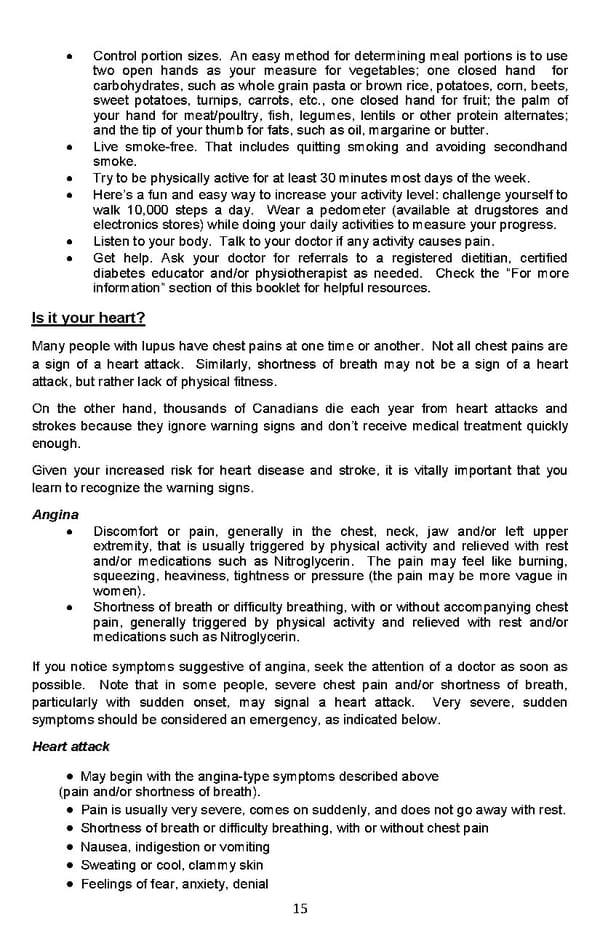• Control portion sizes. An easy method for determining meal portions is to use two open hands as your measure for vegetables; one closed hand for carbohydrates, such as whole grain pasta or brown rice, potatoes, corn, beets, sweet potatoes, turnips, carrots, etc., one closed hand for fruit; the palm of your hand for meat/poultry, fish, legumes, lentils or other protein alternates; and the tip of your thumb for fats, such as oil, margarine or butter. • Live smoke-free. That includes quitting smoking and avoiding secondhand smoke. • Try to be physically active for at least 30 minutes most days of the week. • Here’s a fun and easy way to increase your activity level: challenge yourself to walk 10,000 steps a day. Wear a pedometer (available at drugstores and electronics stores) while doing your daily activities to measure your progress. • Listen to your body. Talk to your doctor if any activity causes pain. • Get help. Ask your doctor for referrals to a registered dietitian, certified diabetes educator and/or physiotherapist as needed. Check the “For more information” section of this booklet for helpful resources. Is it your heart? Many people with lupus have chest pains at one time or another. Not all chest pains are a sign of a heart attack. Similarly, shortness of breath may not be a sign of a heart attack, but rather lack of physical fitness. On the other hand, thousands of Canadians die each year from heart attacks and strokes because they ignore warning signs and don’t receive medical treatment quickly enough. Given your increased risk for heart disease and stroke, it is vitally important that you learn to recognize the warning signs. Angina • Discomfort or pain, generally in the chest, neck, jaw and/or left upper extremity, that is usually triggered by physical activity and relieved with rest and/or medications such as Nitroglycerin. The pain may feel like burning, squeezing, heaviness, tightness or pressure (the pain may be more vague in women). • Shortness of breath or difficulty breathing, with or without accompanying chest pain, generally triggered by physical activity and relieved with rest and/or medications such as Nitroglycerin. If you notice symptoms suggestive of angina, seek the attention of a doctor as soon as possible. Note that in some people, severe chest pain and/or shortness of breath, particularly with sudden onset, may signal a heart attack. Very severe, sudden symptoms should be considered an emergency, as indicated below. Heart attack • May begin with the angina-type symptoms described above (pain and/or shortness of breath). • Pain is usually very severe, comes on suddenly, and does not go away with rest. • Shortness of breath or difficulty breathing, with or without chest pain • Nausea, indigestion or vomiting • Sweating or cool, clammy skin • Feelings of fear, anxiety, denial 15
 Living Well With Lupus Facts Booklet Page 14 Page 16
Living Well With Lupus Facts Booklet Page 14 Page 16